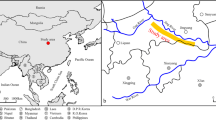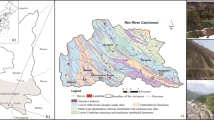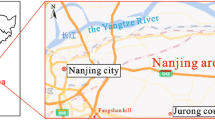Abstract
Due to perennial irrigation, massive loess landslides occur frequently in Heifangtai, Gansu Province in China. Because of the distinctive distribution feature of strata in this area, most of the infiltrated water is discharged slowly from the interface between the loess and the underlying clay layer at the border of the terrace, which forms numerous springs on the cliff-like steep slope around the loess platform. Loess landslides in Heifangtai mostly are triggered by local seepage and erosion due to extensive irrigation, which often occur periodically at the same site, and their scales tend to expand constantly. To account for these phenomena, a field test was conducted near a landslide edge at the eastern margin of Heifangtai, in which the groundwater flow direction was measured by a colloidal borescope, and the equipotential line was determined by the hydraulic head. The results show that the concave topography formed by past landslides can deflect groundwater, causing it to flow to the center of the landslide site. Besides, the failure mechanism of loess landslides were analyzed and discussed, considering the action of groundwater seepage and surface runoff. Then, based on the results of numerical simulation, the changing characteristics of the loess landslides in Heifangtai were summarized briefly in four stages, i.e., (1) seepage erosion at the toe of the slope, (2) small-scale landslides and the convergence of groundwater flow, (3) transportation of deposits and periodic recurrence of slope failure at the same site, and (4) the potential recurrence of a larger landslide in this area.















Similar content being viewed by others
References
Dawson EM, Roth WH, Drescher A (1999) Slope stability analysis by strength reduction. Géotechnique 49(6):835–840
Derbyshire E (2001) Geological hazards in loess terrain, with particular reference to the loess regions of China. Earth Sci Rev 54(1):231–260
Derbyshire E, Meng XM, Dijkstra TA (2000) Landslides in the thick loess terrain of North-West China. Wiley, Chichester
Dijkstra TA (2001) Geotechnical thresholds in the Lanzhou loess of China. Quat Int 76–77(1):21–28
Dong Y, Zhang MS, Liu J, Sun P, Jia J (2014) Loess landslides respond to groundwater level change in Heifangtai, Gansu province. In: Landslide science for a safer geoenvironment: vol. 2: Methods of landslide studies. Springer, Cham, pp 227–231
Gao GR (1988) Formation and development of the structure of collapsing loess in China. Eng Geol 25(2–4):235–245
Guo P, Meng X, Li Y, Chen G, Zeng R, Qiao L (2015) Effect of large dams and irrigation in the upper reaches of the Yellow River of China, and the geohazards burden. Proc Geol Assoc 126(3):367–376
Hu W, Zhang M, Zhu L, Sun P, Cheng X, Jia J (2014a) Research on prediction methods of surges induced by landslides in the three gorges reservoir area of the yellow river. In: Landslide science for a safer geoenvironment: volume 2: Methods of landslide studies. Springer, Cham, pp 209–214
Hu W, Zhu L, Zhang M, Pei Y, Bi J (2014b) Analyses of the changes of loess engineering properties induced by irrigation. In: Landslide science for a safer geoenvironment: vol. 2: Methods of landslide studies. Springer, Cham, pp 215–220
Jia J, Zhu LF, Hu W (2013) The formation mechanism and disaster mode of loess landslides induced by irrigation in Heifangtai, Gansu Province: a case study of the 13th landslide in Jiaojiayatou. Geological Bulletin of China 32(12):1968–1975 (in Chinese with an English summary)
Kearl PM (1997) Observations of particle movement in a monitoring well using the colloidal borescope. J Hydrol 200(1–4):323–344
Kearl PM, Roemer K, Rogoff EB, Renn RM (1999) CharacterIzation of a fractured aquifer using the colloidal borescope. Adv Environ Res 3(1):67–73
Li T, Xing X, Li P (2015) The landslides induced by the released inclusion water of the frozen soil in the side of the Heifangtai loess platform, Gansu Province, China. Engineering Geology for Society and Territory 1:217–221
Liu DS (1985) Loess and environment. Science Press, Beijing (in Chinese)
Lu N, Godt JW, Wu DT (2010) A closed-form equation for effective stress in unsaturated soil. Water Resour Res 46(5):567–573
Matheron G (1963) Principles of geostatistics. Econ Geol 58(8):1246–1266
Peng J, Fan Z, Wu D, Zhuang J, Dai F, Chen W, Zhao C (2015) Heavy rainfall triggered loess–mudstone landslide and subsequent debris flow in tianshui, China. Eng Geol 186:79–90
Qian SZ (2014) Study on the effect of water content on shearing strength parameters of unsaturated loess. Appl Mech Mater 638-640:585–588
Shi JS, Wu LZ, Wu SR, Li B, Wang T, Xin P (2016) Analysis of the causes of large-scale loess landslides in Baoji, China. Geomorphology 264:109–117
Sun P, Zhang M, Zhu L, Pei Y, Cheng X (2014) An in-situ darcy method for measuring soil permeability of shallow vadose zone. In: Landslide Science for a Safer Geoenvironment: vol. 2: Methods of Landslide Studies. Springer, Cham, pp 189–194
Tang YM, Xue Q, Li ZG, Feng W (2015) Three modes of rainfall infiltration inducing loess landslide. Nat Hazards 79(1):137–150
Wang JD (1992) A mechanism of high-speed loess landslides——saturated loess creepig liquefaction. Geological Review 38(6):532–539 (in Chinese with an English summary)
Wang JJ, Liang Y, Zhang HP, Wu Y, Lin X (2014) A loess landslide induced by excavation and rainfall. Landslides 11(1):141–152
Wang ZR, Wu WJ, Zhou ZQ (2004) Landslide induced by over-irrigation in loess platform areas in Gansu Province. Chinese J Geol Hazard Control 15(3):43–47 (in chinese with an English summary)
Wen B-P, He L (2012) Influence of lixiviation by irrigation water on residual shear strength of weathered red mudstone in Northwest China: implication for its role in landslides’ reactivation. Eng Geol 151:56–63
Wu LZ, Zhou Y, Sun P, Shi JS, Liu GG, Bai LY (2017) Laboratory characterization of rainfall-induced loess slope failure. Catena 150:1–8
Wu WJ, Su X, Meng XM (2014) Characteristics and origin of loess landslides on loess terraces at Heifangtai, Gansu Province, China. Appl Mech Mater 694:455–461
Xu L, Dai FC, Gong QM, Tham LG, Min H (2012a) Irrigation-induced loess flow failure in Heifangtai platform, North-West China. Environ Earth Sci 66(6):1707–1713
Xu L, Dai FC, Tham LG, Tu XB, Min H, Zhou YF, Wu CX, Xu K (2011) Field testing of irrigation effects on the stability of a cliff edge in loess, North-west China. Eng Geol 120(1–4):10–17
Xu L, Dai FC, Tu XB, Tham LG, Zhou YF, Iqbal J (2014) Landslides in a loess platform, North-West China. Landslides 11(6):993–1005
Xu L, Qiao X, Wu C, Iqbal J, Dai F (2012b) Causes of landslide recurrence in a loess platform with respect to hydrological processes. Nat Hazards 64(2):1657–1670
Zhang D, Wang G, Luo C, Chen J, Zhou Y (2008) A rapid loess flowslide triggered by irrigation in China. Landslides 6(1):55–60
Zhang F, Wang G, Kamai T, Chen W (2014) Effect of pore-water chemistry on undrained shear behaviour of saturated loess. Q J Eng Geol Hydrogeol 47:201–210
Zhang F, Wang G, Kamai T, Chen W, Zhang D, Yang J (2013) Undrained shear behavior of loess saturated with different concentrations of sodium chloride solution. Eng Geol 155(6):69–79
Zhang M, Liu J (2009) Controlling factors of loess landslides in western China. Environmental Earth Sciences 59(8):1671–1680
Zhang ZY (1996) Regional environmental geology problems and treatments of loess plateau. Science Press, Beijing (in Chinese)
Zhou P, Wen A, Zhang X, He X (2012) Soil conservation and sustainable eco-environment in the Loess Plateau of China. Environ Earth Sci 68(3):633–639
Zhou YF, Tham LG, Yan RWM, Xu L (2014a) The mechanism of soil failures along cracks subjected to water infiltration. Comput Geotech 55(2):330–341
Zhou YF, Tham LG, Yan WM, Dai FC, Xu L (2014b) Laboratory study on soil behavior in loess slope subjected to infiltration. Eng Geol 183:31–38
Zhuang JQ, Peng JB (2014) A coupled slope cutting—a prolonged rainfall-induced loess landslide: a 17 october 2011 case study. Bull Eng Geol Environ 73(4):997–1011
Acknowledgements
This research was financially supported by the National Natural Science Foundation of China (Nos. 41372277, 41272336 and 41202216) and the Research Program of Zhejiang Provincial Communication Department (Nos. 2014H21 and 2016-2-16).
Author information
Authors and Affiliations
Corresponding author
Rights and permissions
About this article
Cite this article
Pan, P., Shang, Yq., Lü, Q. et al. Periodic recurrence and scale-expansion mechanism of loess landslides caused by groundwater seepage and erosion. Bull Eng Geol Environ 78, 1143–1155 (2019). https://doi.org/10.1007/s10064-017-1090-8
Received:
Accepted:
Published:
Issue Date:
DOI: https://doi.org/10.1007/s10064-017-1090-8




